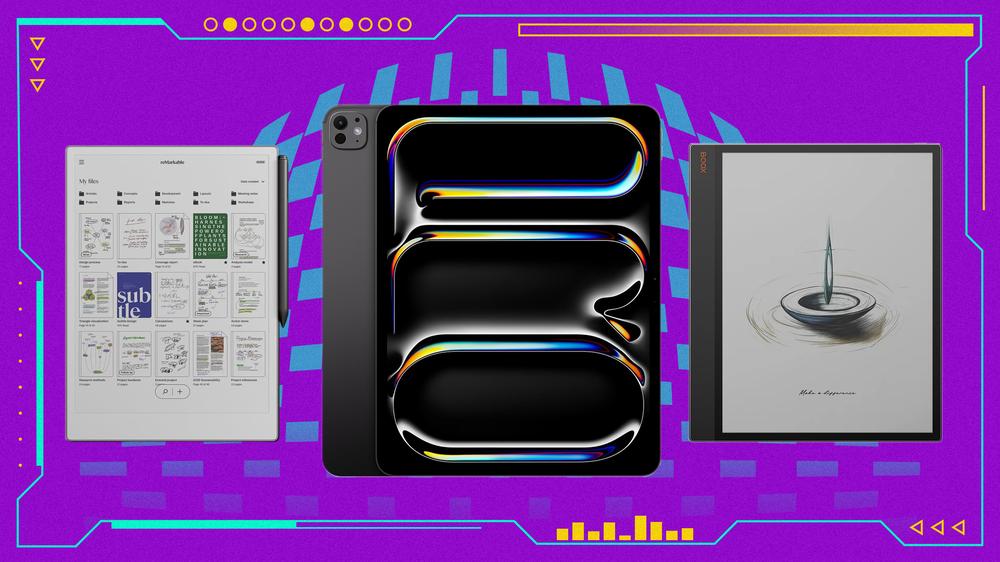Regardless of where you're at in your studies, a great tablet can be a major asset to your learning and note-taking (and can even provide a little entertainment on the side). But with so many options to choose from – different sizes and type of screen, different operating systems, different hardware – how do you know what's the right choice for you, and if you'll be better served by a laptop than a tablet? Buckle in, because that's exactly what I'm going to answer. These are the best tablets for students in 2025.
While the traditional choice for students of all stripes is a laptop or Chromebook, a great tablet can be a major asset and fill a niche that a most laptops can’t. They're thinner, lighter, and more portable. For reading books, they offer a handheld experience instead of swiping a touchpad. For taking notes, you have your choice of typing or handwriting using a stylus.
A premium tablet, like our top pick, the iPad Pro, can also be a great tool for artists, allowing you to take your projects with you on the go and have access to a wide range of tools and applications so you can take advantage of that creative spark whenever and wherever it may strike.
All it takes is a quick look around Amazon to see that there are hundreds of choices to pick from. This is made even more complicated by the fact that many vendors are selling tablets that have been released across multiple years without always making it clear they’re doing so. To help you find the best tablet to meet your needs, these are the most important things to consider when shopping:
Size
The first thing to consider is how large you want your tablet to be. For handwriting, it can be wise to target the size of a typical sheet of paper (8.5 x11 inches) so that feels familiar and natural straight away. Depending on the size of your bag, you may want to scale up or down. There is really no wrong answer here. Some people prefer larger tablets (especially if they are going to be using the same device to watch movies and play games), while others prefer something more compact that can easily slide in and out of a bag. Carefully consider how you will be using the tablet and what you feel would be reasonable to carry and use in different environments.
Apple or Android
The next consideration is a big one: Do you want to go with Apple or Android? If you are already in the Apple ecosystem, choosing an iPad is a natural decision. If you're an Android user or don't have any other Apple devices already, an Android tablet may be the better choice. The decision isn’t black or white, however, so here are some important considerations to guide your decision:
- Apple's iPad is about as ubiquitous as pieces of technology come. Its widespread adoption has allowed it to garner a flourishing app library for pretty much anything a student might want or need to do. It’s also easy to learn and has a refined user experience that even literal toddlers can navigate easily. Apple’s guard over its app ecosystem and user experience means less freedom in settings and applications, however, so anyone that wants complete control over their device might find themselves limited. Apple also has a long history of making many accessories obsolete with each new generation, forcing you to rebuy them.
- Android, on the other hand, lacks this strict control which has lead to a proliferation of devices with different specs. There are more options, which can make telling the difference hard if you’re not a techie. As a rule, try to stick to known brands with models released in the last couple years for the best performance. While shopping can be more confusing, Android tablets do typically come a little cheaper and offer significantly more freedom with what the user can do and change about them.
TL;DR: The Apple iPad gives you less to worry about with lush app support and a polished experience but usually costs more and is tightly guarded by Apple. Android has many more options, but usually costs less,and doesn’t have the same limitations on apps or user customization.
Performance (Processor and Memory)
While a great tablet can transform the daily life of a student, one that feels slow to use is much more likely to be left in the dorm collecting dust. This comes down to the processor and memory used to drive the experience. The safest bet is to choose something released within the last few years from one of the big names in the field: Apple, Google, Samsung, Asus, Lenovo, etc. If you want to dig in a little more, there’s much more to consider.
This is an area where Apple has a distinct advantage over Android. Because there are fewer tablets to choose from, you can pretty much count on decent performance as long as it’s within a generation or two old. Android, on the other hand, has a dizzying number of processor options to decipher and it can be a bit like Greek, even for dyed in the wool techies.
Like shopping for a new processor for your PC, clock speed and core count matter a great deal and you should always aim for higher numbers here. But I’ll be frank: It really isn’t that simple and it’s possible for two similarly specced chips to perform differently. So, stick to the rule of “newer is better,” read reviews, and do your research.
For memory, try not to go for anything with less than 4GB of memory and, preferably, aim for 6GB or more as your budget allows. This will allow you to run most applications to run smoothly. Higher memory capacity means more multitasking and a better ability to run heavy apps – and that may be exactly what’s required for art, engineering, and design courses.
There is one exception to this, and that’s tablets which use e-ink screens. It’s still advisable to look for tablets with 4GB of memory or more, but devices with a more limited scope, like the Remarkable Paper Pro, do well with only 2GB. If it’s running Android, though, stick to the rule of 4GB or above.
Camera
No student wants to be on a potato cam, so if there are virtual classes to attend, this spec is worth considering. Tablets aren't especially known for their camera quality, but you should still try to find a slate with at least a 1080p front-facing camera. This will allow you attend classes and to take meetings with confidence, knowing you’re not fuzzy.
The Best Laptop for Students
The Best Tablet for Students on a Budget
The Best 2-in-1 Tablet PC
Best Digital Notebook
Best E-Ink Student Tablet
Best for Student Tablet for Learning
Best Replacement for Paper Notes
What’s the difference between a digital notebook and a tablet?
This largely comes down to the three key elements: the operating system, display, and how much its design caters to handwriting. A normal tablet aims to offer a little bit of everything, from entertainment, reading, running apps, playing games, and scrolling social media. A digital notebook is a much more targeted device and, though some (such as Boox's) run Android and allow you to download apps, they usually cater to reading and writing above all. Digital notebooks often use e-ink screens, similar to a Kindle, which are great for long reading and writing sessions. These devices usually use come with a stylus and have a micro texture applied to their screens to provide a more paperlike writing experience.
Should I get a laptop or a tablet for school?
This depends on what you’ll be doing. Most students do a lot of reading, and if you can find e-books for your course, a tablet can be a great way to save space and weight while still having a handheld reading experience. Likewise, if you prefer handwriting your notes, a tablet (or 2-in-1) is the clear way to go. If you don’t care about writing by hand or scrolling your textbooks, a laptop, even of the gaming variety, is a reliable alternative.
Another thing to consider here is how prone you are to distraction. A laptop is a jack of all trades, but the temptation to log on to social media or let yourself get distracted with a game or website is real. Many of the best tablets for students prioritize offering a distraction-free, or at least distraction-light, experience.
What accessories should I get for my tablet?
If you’ve decided to get a tablet, the natural next question is what accessories you’ll need to buy to make the most of it. You’ll definitely want to pick up a case to keep it safe and you’ll also want to pick up a stylus and keyboard for writing.
While many tablets come with a stylus, some of the most popular charge extra for this as an optional accessory. A paperlike screen protector is also worth considering if your tablet comes with a glossy screen. For keyboards, first see if there is anything offered by the brand itself. Many tablets have integrated keyboard cases available, ensuring everything works seamlessly. If you’re buying third party, remember: Go for something thin to easily slide in your bag, light so it’s not weighing you down (basically, avoid desktop keyboards), has long battery life, and, because there are so many options, choose one that has plenty of positive reviews. A few that I personally recommend are the Logitech MX Keys Mini, the Cherry KW 9200, the Razer Joro for gaming (it also works on PC, Windows handhelds, and the Steam Deck), and the Mistel Air One if you prefer mechanical keys.
Another optional accessory I recommend for home use is a height-adjustable stand. This is especially useful if you’re sitting at a desk to type or watch a movie as they elevate the screen to a more comfortable viewing angle.

 Grammarly svela i nuovi agenti AI: danno un voto ai testi come dei professori
Grammarly svela i nuovi agenti AI: danno un voto ai testi come dei professori